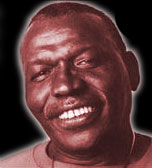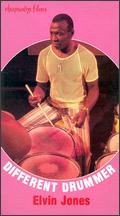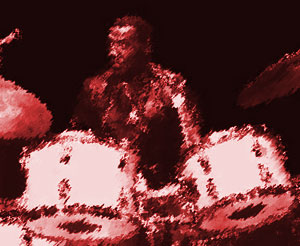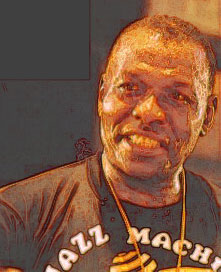
|
||
| Volume III, Issue II | Summer 2004 | |
| Summer 2004 Home Page |
| Culture/ Technology |
| Fiction |
| Music |
| Poetry |
| Theater |
| About / Contact |
| Archive |
| Current Home Page |
Elvin burns on
Celebrating the shimmering, incandescent pulse of jazz
 In the early 1980s, the Ken Cinema in San Diego hosted a night of jazz films. The highlight, as far as I and a few of my acquaintances were concerned, was to be a documentary, "Different Drummer: Elvin Jones."
In the early 1980s, the Ken Cinema in San Diego hosted a night of jazz films. The highlight, as far as I and a few of my acquaintances were concerned, was to be a documentary, "Different Drummer: Elvin Jones."
I attended with journalist Martin Wisckol and we ran into a few folks we knew from jazz circles, trumpeter James Zollar and drummer Charles McPherson Jr. among them.
This was a few years before Clint Eastwood's "Bird" and Bertrand Tavernier's "Round Midnight" starring saxophonist Dexter Gordon, and long before Ken Burns' jazz history series aired by PBS. To see jazz on screen at all was rare. To experience one of our heroes from the 1960s revolution, generically called the avant garde, on film was an unprecedented treat.
 After a few clips focusing on the swing era, it was time for the Jones film. The climax, naturally, would be Elvin's specialty, a firmament-shaking solo. The moment arrives, and Elvin is burnin' – slashing cymbals, ripping off thunderous rolls, sweat flying off his face and streaming down his arms, leading up to the inevitable explosive barrage, when the screen erupts in flames and the image of Elvin on his throne of steel and skins dissolves into singed celluloid, and he disappears altogether. We were left staring at nothing but a lit, white screen with stains and tears on it.
After a few clips focusing on the swing era, it was time for the Jones film. The climax, naturally, would be Elvin's specialty, a firmament-shaking solo. The moment arrives, and Elvin is burnin' – slashing cymbals, ripping off thunderous rolls, sweat flying off his face and streaming down his arms, leading up to the inevitable explosive barrage, when the screen erupts in flames and the image of Elvin on his throne of steel and skins dissolves into singed celluloid, and he disappears altogether. We were left staring at nothing but a lit, white screen with stains and tears on it.
"That shit was so hot, it done burned up the film," somebody said, unleashing a concatenation of laughter.
Yes – anyone who had experienced Jones' playing felt that was entirely plausible, for while all of us are, of course, elements of nature, Elvin was a cosmic dynamo, a torrent of energy, a relentless cascade. Anybody who heard John Coltrane's "A Love Supreme" knew that, as Carlos Santana stated in an article by George Varga in the San Diego Union-Tribune on June 1, 2004:
"When that intro comes in on 'A Love Supreme,' it's like the gates of heaven opening. In fact, when I die, if I don't hear 'A Love Supreme,' I'll turn back, I'll know I'm in the wrong place ...
"When I hear Elvin's music, I hear the pyramids, I hear African and pre-Columbian music, and I hear the future. Elvin's the beat of life itself and his music transcends 'clever or cute' or any superlatives."
In the article, Santana rails against the scarce publicity following Jones' death on May 18 in Manhattan at the age of 76, and expresses his sense of frustration that someone as vital as Jones was met with such a lack of attention.
 A similar sense of frustration enveloped the crowd at the Ken about 20 years ago, though without the drama of death. We had suddenly been robbed of the vitality that Elvin Jones was imparting to us. We were deprived by a power beyond our control – an inopportune technical failure, the impertinence of a manmade apparatus – and it seemed insidious, especially to the musicians. All too often, the music, the jewel of African-American culture, has been ripped off, repressed and written off. It was a daily experience, so at the moment when you believe that by serendipity you are granted a
moment to revel in the triumph of the artistry, creativity and transcendence that Elvin Jones symbolized, and the goddamn film burns up – just more bullshit, man. Well, somehow, they fixed the film and there was Elvin up there on the screen reincarnated, smashing away again. And that was
Elvin in life, too.
A similar sense of frustration enveloped the crowd at the Ken about 20 years ago, though without the drama of death. We had suddenly been robbed of the vitality that Elvin Jones was imparting to us. We were deprived by a power beyond our control – an inopportune technical failure, the impertinence of a manmade apparatus – and it seemed insidious, especially to the musicians. All too often, the music, the jewel of African-American culture, has been ripped off, repressed and written off. It was a daily experience, so at the moment when you believe that by serendipity you are granted a
moment to revel in the triumph of the artistry, creativity and transcendence that Elvin Jones symbolized, and the goddamn film burns up – just more bullshit, man. Well, somehow, they fixed the film and there was Elvin up there on the screen reincarnated, smashing away again. And that was
Elvin in life, too.
For five years with the John Coltrane Quartet, he had been a driving force in a group that transformed music and changed the world in ways most people aren't even hip to. The interplay between Jones and his colleagues, and especially 'Trane, was unprecedented for its combined intensity and complexity. The recordings are treasured now four decades after they were created and will be replayed, analyzed and still amaze four decades and four centuries hence.
Elvin broke up with Coltrane for whatever reason in 1966 – some say he was upset that 'Trane brought another drummer, Rashied Ali, into the band and why wouldn't he be? It would be like asking Picasso to move his paintings aside in a gallery to accommodate Braque. But 'Trane was a restless, relentlessly searching soul – the embodiment of the improviser's ethic placing innovation as the supreme value. He wasn't content to re-create masterpieces.
Much of the world has never caught up to what the quartet was doing, but a corner of the world did after the quartet had broken up and Coltrane had passed away. Jimi Hendrix biographers noted that Hendrix had told his drummer, Mitch Mitchell, to emulate Elvin. Elvin's influence was manifested in drum-driven acid rock and electric-jazz fusion, notably in John McLaughlin's Mahavishnu Orchestra. Later, McLaughlin and Santana teamed up to perform a Coltrane-inspired album, "Love, Devotion, Surrender," which includes Coltrane compositions "A Love Supreme" and "Naima."
In one of the unlikeliest of scenarios, Elvin's talents were tapped in a ludicrous rock 'n' roll Western movie, "Zachariah," primarily a vehicle for the James Gang and Country Joe and the Fish, but incorporating Elvin as a gunslinger named Job Cain and, even weirder, the Count Basie band. The musical highlight of this absurdity is Elvin playing a drum solo in the middle of the desert. Anyone who has watched that and had the premonition that Elvin's playing didn't sound quite right was right. As legendary studio drummer Earl Palmer recounted in his autobiography, the audio to the scene accidentally was lost, so Palmer was called upon to dub in the solo, a feat in itself, he admitted.
Raised in Pontiac, Mich., Elvin Jones was the youngest of 10 children. Two of his brothers, cornetist Thad Jones and pianist Hank Jones, had already had an impact on the national jazz scene by the time Elvin started gigging in the 1950s. He honed his skills in Detroit's fertile jazz circle, then moved on to New York where he became increasingly in demand. He hooked up with Coltrane as the saxophonist was getting deep into a personal spiritual and musical quest. The saxophonist was ready to leave the constraints of bebop behind and forge a bolder, freer path that would lead to wondrous creations and also generate tremendous criticism and opposition.
The music makes the case that both Coltrane and Jones had a liberating effect on each other.
From various accounts, Jones played off the bandstand as ferociously as he played on it. In one publicized incident, he borrowed 'Trane's new car and wrapped it around a tree. Coltrane reportedly responded in the press, "I can get a new car, but there's only one Elvin."
An acquaintance of mine told me he accompanied Grover Mooney – one of the most creative drummers I've heard – to the Dayton, Ohio, jazz club of Gilly's when Mooney was living in Cincinnati in the 1970s. Outside the club, they unexpectedly ran into Elvin Jones at which point Mooney and Jones both began swearing at each other and sparring with blows that appeared driven by vicious, mutual hatred. When things seemed to be on the verge of getting out of hand, they both abruptly stopped and embraced each other, apparently old friends, my source said.
 After leaving Coltrane, Jones persisted for the following three decades as the leader of his own groups, with his wife, Keiko, managing his career, and splitting time between residences in New York and Japan. His groups became a training ground for young aspiring musicians, some of whom went on to be stars in their own right – Joshua Redman, Nicholas Payton and Coltrane's son, Ravi Coltrane, among them.
After leaving Coltrane, Jones persisted for the following three decades as the leader of his own groups, with his wife, Keiko, managing his career, and splitting time between residences in New York and Japan. His groups became a training ground for young aspiring musicians, some of whom went on to be stars in their own right – Joshua Redman, Nicholas Payton and Coltrane's son, Ravi Coltrane, among them.
The sheer power of Elvin's drumming was overwhelming, which made it easy to overlook the technical mastery that enabled him to achieve his groundbreaking approach. For one thing, he had a very deep sound on his various skin heads, which he used to set up a rolling thunder underneath the nearly constant shimmer and sizzle of his cymbals. I hear a great deal of melody in Elvin's playing, though it tends to be masked by the textural aspect. Often it sounded as if Elvin were creating several different planes of sound simultaneously. Never before had one drummer so successfully integrated so many different percussive effects into the dual role of rhythmic pulse and coloration – a style that maximized the polyrhythmic capabilities of the traps set, the single-most important instrumental contribution of jazz.
The traps set enables polyrhythms that otherwise would take a few hand drummers and percussionists to create. Elvin took that possibility to the extreme, although it would be rash to overlook the contributions of Max Roach, Art Blakey and Kenny Clarke in this regard. But more than anyone else up to his engagement with Coltrane, Jones got away from the repetitive use of one element to keep time and incorporated multiple elements in maintaining the pulse. It's been said that Elvin replicated the multilayered polyphony achieved by West African drum ensembles.
Jones articulated his approach in a 1977 Downbeat article:
"Some people are more sensitive to rhythmic pulses, and the more sensitive you are, the more you can utilize the subtleties of timekeeping. For instance, when I am playing I can use the bass drum beater at a minimum because it's not necessary for me to sustain the pulse. I can get just as much of a dynamic thrust with the hi-hat or a light touch on the ride cymbal and balancing the natural pulsation of say 4/4 or 3/4 time throughout the different components of the drum set. Like hitting one on the cymbal, two on the hi-hat and three on the bass drum; starting with that as the foundation, then changing the three on the bass or the high hat and putting the one on the cymbal and then continually changing these three things.
"It's just as effective as keeping the same pulse going on one component – but it's just not conventional. The conventional thing is to use the hi-hat for the after beat and use the bass drum for the underlying 4/4 or 3/4 rhythm to keep the steady pulsation. ... I just think you have to use all of the drum set all of the time."
One thing is clear in Jones' discussion – his focus riveted on the pulse, which was a fundamental difference with the direction Coltrane headed in, as evidenced by some of his final works before he died in 1967, such as "Interstellar Space" and "Expression" in which the music is pulseless or, at most, has a free-flowing, shifting pulse.
For all of his association with the far-outness and the free jazz of the 60s, Elvin never deviated from his adherence to the pulse, and the concept of building on that through polyrhythms and syncopation (essentially African musical values), the impulse in U.S. musical circles associated with words like swing and funk.
 Stravinsky broke it down in an interview once, saying that jazz essentially is friction generated by the motion of variable components against the steady elements of pulse and harmony. And Elvin, having been nurtured in the hothouse of swing and its offspring, could swing like nobody's business.
Stravinsky broke it down in an interview once, saying that jazz essentially is friction generated by the motion of variable components against the steady elements of pulse and harmony. And Elvin, having been nurtured in the hothouse of swing and its offspring, could swing like nobody's business.
He was one of a handful of musicians I had to see at least once and a few years ago, I caught his group at the Catalina Bar and Grill when I happened to be in L.A. It was a Saturday night, the same night the Playboy Jazz Festival was going on at the Hollywood Bowl. As I was driving along listening to a live radio broadcast from the festival, with Ernestine Anderson tearing up the blues, I decided I had to split from my friends, who had only a vague inkling of who Elvin Jones was, and make the scene at the Catalina. I figured there were going to be a lot of Elvin's musician friends coming by the Catalina after the festival shut down to party and sit in.
I was one of about five people in the audience and two of them were other well-known drummers I recognized. I was disappointed that here was one of the greatest and hardly anybody showed up, even on a night when the town was flooded with jazz musicians and fans. Delfeayo Marsalis was playing trombone and I can't remember the names of the other musicians, but the music was incandescent and Elvin was on fire. What got to me most was his uninhibited exuberance. Despite the sparse audience, he was swinging his ass off, driving the band to the maximum. Having come from a milieu in which performing professionally meant playing nightclubs day by day, Elvin seemed to relish the free-wheeling atmosphere, and to be utterly unconcerned with the sparse audience. I really felt honored when he came by my table at the end of a set, thanked me for stopping by and said something like "Hey man, good to see you again."
Keiko was there and it was touching to see that after 30 years or so of watching her old man perform, she was still digging the music, urging him on, "Yeah, Elvin, go man, play it man." She was his biggest cheerleader, even when there were only five people there. Speaking of Elvin's persistence in continuing to perform up to his death, even when he was obviously suffering, Keiko was quoted as saying, "He wanted to be behind his kit. That's where he was happiest."
Elvin has split and is swinging in polyphonic iridescence in another sphere, but the audio-video archive of my mind is impermeable to destruction, as long as I'm hanging around this here joint.
![]()
Summer 2004 Music Section | Summer 2004 Main Page
Current Music Section | Current Home Page
Copyright ©
Reprinted by permission of author, who retains all copyright and control.